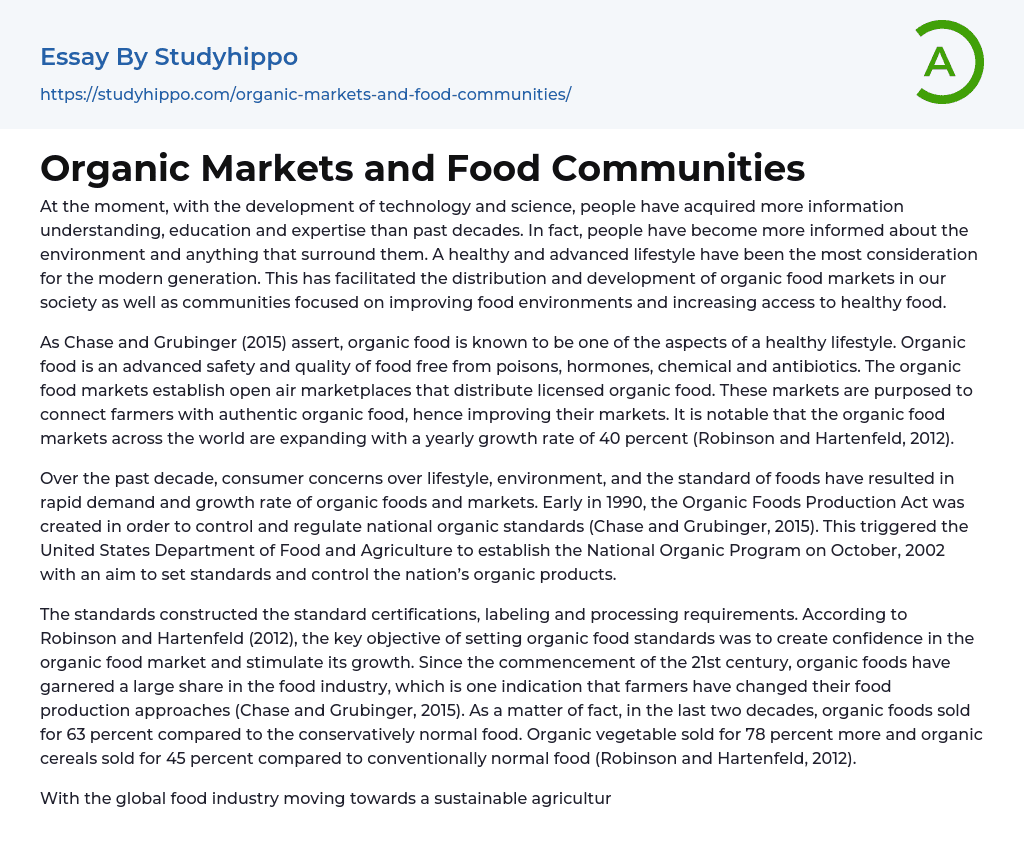At the moment, with the development of technology and science, people have acquired more information understanding, education and expertise than past decades. In fact, people have become more informed about the environment and anything that surround them. A healthy and advanced lifestyle have been the most consideration for the modern generation. This has facilitated the distribution and development of organic food markets in our society as well as communities focused on improving food environments and increasing access to healthy food.
As Chase and Grubinger (2015) assert, organic food is known to be one of the aspects of a healthy lifestyle. Organic food is an advanced safety and quality of food free from poisons, hormones, chemical and antibiotics. The organic food markets establish open air marketplaces that distribute licensed organic food. These markets are purposed to connect farmers with authentic
...organic food, hence improving their markets. It is notable that the organic food markets across the world are expanding with a yearly growth rate of 40 percent (Robinson and Hartenfeld, 2012).
Over the past decade, consumer concerns over lifestyle, environment, and the standard of foods have resulted in rapid demand and growth rate of organic foods and markets. Early in 1990, the Organic Foods Production Act was created in order to control and regulate national organic standards (Chase and Grubinger, 2015). This triggered the United States Department of Food and Agriculture to establish the National Organic Program on October, 2002 with an aim to set standards and control the nation’s organic products.
The standards constructed the standard certifications, labeling and processing requirements. According to Robinson and Hartenfeld (2012), the key objective of setting organic food standards was to creat
confidence in the organic food market and stimulate its growth. Since the commencement of the 21st century, organic foods have garnered a large share in the food industry, which is one indication that farmers have changed their food production approaches (Chase and Grubinger, 2015). As a matter of fact, in the last two decades, organic foods sold for 63 percent compared to the conservatively normal food. Organic vegetable sold for 78 percent more and organic cereals sold for 45 percent compared to conventionally normal food (Robinson and Hartenfeld, 2012).
With the global food industry moving towards a sustainable agriculture system, organizations and governments are finding advanced practical alternatives for agriculture. Studies have revealed that organic systems of production lead to great achievement even without price premiums (Robinson and Hartenfeld, 2012). Probably, this could be as a result of temporary higher produces and lower input costs during dry periods as matched to conventional farming. Most consumers are considering organic markets and food communities to facilitate their healthy lifestyle.
It is worth noting that that traditional farms use genetically altered seeds and chemicals to increase produces and for pest management. Due to this, governments and organizations are supporting communities to come together so that sustainable production of food can be facilitated. The food communities are concerned largely with ecological and health ethics as the key driver for consumers to buy organic food. Based on the market data provided by Chase and Grubinger (2015), the organic market has lately reported 7.5 billion sales. The stable growth in sales is facilitated by the fact that many consumers in the food industry have started considering organic foods.
The organic markets and food communities
have played a great role in constructing more sustainable, healthier communities and methods to food. Consumer attitudes, demand and perceptions towards organic food is steadily growing. In fact, the organic market is perceived as the future food market but for this reputation to become a reality, there is need to maintain its development patterns. Governments and organizations should continue establishing organic markets and food communities in order to drive positive change in our society.
- Beef essays
- Beer essays
- Beverages essays
- Bread essays
- Burger essays
- Cake essays
- Coconut essays
- Coffee essays
- Cooking essays
- Crowd essays
- Cuisines essays
- Dairy essays
- Desserts essays
- Dinner essays
- Drink essays
- Fast Food essays
- Favorite Food essays
- Food Safety essays
- Food Security essays
- Food Waste essays
- Fruit essays
- Ginger essays
- Hamburger essays
- Ice Cream essays
- Juice essays
- Lemon essays
- Meal essays
- Meat essays
- Oreo essays
- Organic Food essays
- Pizza essays
- Rice essays
- Sainsbury essays
- Sugar essays
- Taste essays
- Tea essays
- Wine essays
- Bank essays
- Banking essays
- Corporate Finance essays
- Credit Card essays
- Currency essays
- Debt essays
- Donation essays
- Enron Scandal essays
- Equity essays
- Financial Accounting essays
- Financial Crisis essays
- Financial News essays
- Financial Ratios essays




